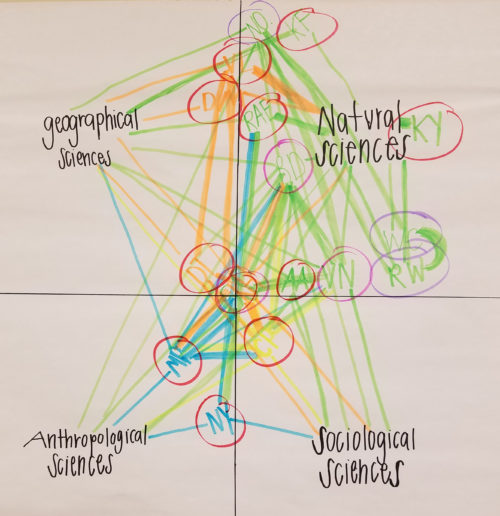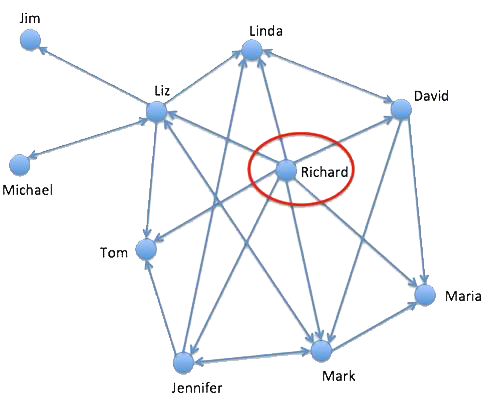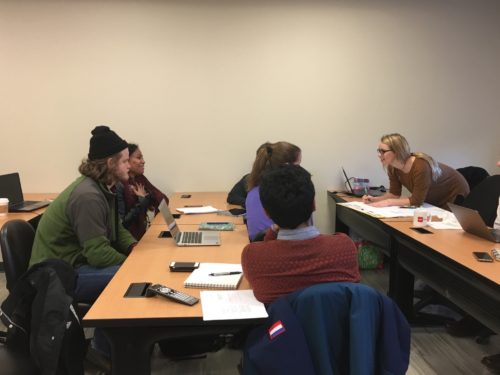Social Networking: Beyond the Likes and Shares
Natalie Yee, Rachel Eberius ·Natalie Yee and Rachel Eberius
Social networks are not just places where we post photos or share updates on our lives. They can be described more broadly to include a series of social interactions and personal relationships. We explored this other definition in class as it related to our work and personal interactions within the class.
To kick things off, we created a social network diagraph depicting the connections we had to different realms of study and to people in the class outside of our weekly discussions. The first part defined our field of study (as indicated by our initials) as one of the four disciplines we focus on in this class: natural sciences, geographical sciences, anthropological sciences, and sociological sciences. The position of our initials in relation to other boxes demonstrated the relatedness of our work to these other sciences. The second part connected lines from the person to either another discipline or another person in the class. The more we felt connected to said discipline or person in terms of frequency of communication and similarities in research goals and interests, the thicker the line would become.

We noticed a series of interesting patterns and trends that emerged from our class. One of the most notable trends was that many people found it difficult to identify as one discipline, as research and work becomes more interdisciplinary. No discipline remained completed isolated or contained within its own box.
Interestingly, natural sciences demonstrated the strongest ties with other natural scientists, whereas the people in other disciplines had more diverse connections. We derived that this may be due to the nature of the discipline. Anthropology, for example, intentionally tries to “break free” from its own bubble to reach a better and more rounded understanding of the situation.
Another pattern that emerged was the potential peer pressure to make links and justifications for those links. This involves the concept of reciprocity. The diagraph was drawn during class, so other people could see who had made connections with whom and why. One may have fabricated connections or stated a mutual or stronger connection than if the diagraph were done individually and presented later. There was also pressure for those that did not have many connections out of fear of being an outlier or marginalized. Hearing the justifications for these links (qualitative data) help to give an explanation to the quantitative data.

If the class were to make a social learning event, we concluded that we would want people to best represent the diversity of the class. We picked Suzi because she is far into her work and would represent the Annapolis sector. Another candidate would be Krystal because she is new this semester and therefore has a more fringe perspective with limited connections. We included David also because of his fringe perspective but from the geographical sciences side as opposed to Krystal’s natural sciences viewpoint. We wanted to include Christina because not only was she the only sociologist, but she felt connections to the other disciplines. Lastly, we wanted to have someone from the Eastern Shore represent the class to ensure that this perspective was not overshadowed. This grouping of people would bring together ideas from diverse epistemologies and research backgrounds.

This transitioned nicely into incorporating the establishment of stakeholders for a social learning experience. We discussed the value of two key components: the frequency of communication and the nature of the communication between stakeholders. A higher frequency of communication allows a deeper, more intimate understanding of someone’s epistemology and the reasoning behind it, while the nature of communication involves how effectively the information was communicated. We concluded that it is necessary to first establish a space where perspectives can be heard without judgment or “home field advantage”, or else discussing a “frequent” idea will have no impact.

Lastly, we attempted to return to a question that has persisted for the past few weeks: Do we let the issues choose the stakeholders or the stakeholders choose the issues? This problem was initially discussed when dealing with assessing the priority issues for report cards. Are the most important issues the ones that the stakeholders bring up? And what if there is an issue present that some stakeholders are not aware of/not concerned about? In a social network analysis context, this brings up the dilemma of which stakeholders would be most important to include to best represent issues that are not only relevant to stakeholders, but to bring to attention issues that may be overlooked.
Social networks go beyond your friend list on Facebook or the number of followers you have on Instagram. They represent connections to people and concepts not only based on the number of interactions, but on the profound understanding of what these interactions mean to you and how they have influenced your line of thinking.
References:
- Kim, J. H. (2011, November 10). A perspective of why financial crises happen, and how to predict them before they happen. Retrieved on March 8, 2017.
- Hanneman, R. A. & Riddle, M. (2005). Introduction to social network methods. Riverside, CA: University of California, Riverside (published in digital form)
- Schaub, W. P. (2011, February 22). Rangers Awareness Sessions – What would be interesting 2U? Microsoft Developer. Retrieved on: March 6, 2017. Retrieved from:
- “Social network.” Def.1. OxfordDictionaries.com. Oxford Dictionaries. Retrieved on March 6, 2017.
Next Post > On the trail of iconic Parisian scientists
Comments
-
Suzanne Spitzer 9 years ago
Nice description of our class activity. I agree that many of us had trouble committing to just one discipline, even with some 2-dimensional freedom to move ourselves around our discipline’s box to reflect a closer or weaker relationship with other disciplines. As we discussed at the end of class, several of us do not strongly identify with one discipline over the others, perhaps because we recognize that our self-identities change depending on context. For example, in a room full of anthropologists, I find that I usually introduce myself as an environmental scientist, but in a room full of scientists I am much more likely to emphasize my background in social sciences. It’s important to play to our diverse strengths and build social networks across disciplines when aspiring towards transdisciplinary research.
-
Alec Armstrong 9 years ago
The quadrants used in our class exercise got me wondering about how network structure varies between academic disciplines in academic institutions. I imagine many interesting patterns could emerge, from differences in training or graduate education organization to differences in how relationship structures map onto the distribution of publication credits.
More generally, I also wonder how different network structures can be meaningfully compared over time. What is the effect of efforts meant to encourage social learning on actual network structure? If successful, these efforts could be considered disturbances to existing network structure. How does the network structure itself affect sensitivity to or resilience following such disturbances?
-
Max Hermanson 6 years ago
Hi, thanks for your comment. Where specifically did you see text running off the screen? We're currently remodeling our website, so it's possible that's causing the problem for you.
-
Killian F 9 years ago
Reading Noelle's comment on how having a representative from each field may be more important than the geographic location made me take another look at the class diagraph. Something that I thought was interesting this time was that the students we identified as being some of the least connected, such as Krystal and David, come from College Park which had the most people and is more central for MEES students than some other locations. It seems like more isolated people didn't come from the more remote locations. I was wondering if other social networks often had the opposite, with more geographic fringe people also being on the fringe socially. For our class social network, it makes some sense that College Park would be the area to draw in more outside people for a class, while MEES students taking the class from other locations are already more connected.
-
V Leitold 9 years ago
I really enjoyed the class activity that Rachel designed for us to illustrate the complexities of social network analysis in real time. I think the question of anonymity is an interesting one – if the exercise had been carried out anonymously, I, for one, would certainly have categorized myself in a different discipline than what I ended up with as a result of some forceful peer pressure in class that made me reconsider my realm of study and choose “geographical sciences” as opposed to “natural sciences”. Unlike in Suzi’s case, however, where she had a hard time committing to just one discipline, in my case the difficulty arose from my own definition of “geographical” vs. “natural” sciences that didn’t exactly match other people’s definitions of these disciplines (an epistemological problem?).
This also reminds me of our discussion regarding the definition of a “stakeholder” – Rachel mentioned the classical definition (i.e. “a person who holds the stake or stakes in a bet”) and a more modern one (i.e. “any group or individual who can affect or is affected by the achievement of the organization's objectives”), but still other definitions emerged from our conversation. Some people felt that the modern definition is too restrictive, and any person/group with a mere concern/interest in the matter should be considered as stakeholder even if they are not affected directly. Others thought that the modern definition is too generous, and not anybody who can affect/is affected by the organization/project should be included, but only those who have the power to make an impact in some way (i.e. people/groups who have a ‘legitimate say’ in the matter). This latter perspective, however, fails to account for potentially marginalized people/groups and those who may at first appear to be powerless but might influence the outcomes during the implementation of the project.
-
Kelly Hondula 9 years ago
I find it interesting and a common phenomenon for people working in interdisciplinary/socio-environmental sciences to have a hard time picking a discipline to affiliate themselves with (just happened recently at SESYNC! https://twitter.com/barbieriiv/status/839679597222506500), however I think it is important for us to reflect on our own expertise and recognize that our backgrounds, experiences, and training often have disciplinary origins. Even though we may be working at the intersection of topics and disciplines, knowing what perspective each individual brings, and therefore each person's unique expertise, is a critical part of studying coupled systems.
Natalie makes a great point here about the important of merging perspectives from qualitative and quantitative data. The lack of reciprocity in social networks is a common challenge for this type of analysis and qualitative data is critical for interpreting those linkages (or lack of linkages!).
-
David Miles 9 years ago
Using social network analysis to help in the stakeholder selection process seems like a novel idea. It was interesting when Dr. Prell said that the collaborators the team worked with never used the recommendations their analysis came up with, and that many perceived stakeholders were not interested in becoming involved in the management of the area. I believe this gets back to the conversation about issues choosing the stakeholders or stakeholders choosing the issues. It would seem in reality, judging from the information from Dr. Prell, that the stakeholders choose the issues. The initial stakeholders even choose who the other stakeholders were! I think the social network analysis tries to allow the issues to have say in the stakeholders, even when the potential stakeholders don't know it or don't care. Is something an issue if the potential stakeholders affected by it don't see it as such?
-
W.Cruz 9 years ago
Great blog Natalie! One thing to mention is that the smaller groups with the least connections perhaps get overshadow with social networks. Usually their perspectives and connections are different than the "most connected". It is important to include marginalized groups to extend the diversity of opinions. Perhaps it could be done with the method Rebecca mentioned!
-
Noelle O. 9 years ago
One thing that I thought about during our class discussion was about whether our class’s social network would look differently if we had done it “anonymously.” I don’t think it would’ve changed too much, because we were basing our network off of work relationships, not personal relationships (although one can lead to the other very quickly).
Although my thesis research does have a management component or application, for the most part, I’m very much in the “natural science” realm. I do agree that one’s setting or audience will influence what you identify as to others. My area of specialization in the MEES program is fisheries, so I’m constantly waffling between describing my field as fisheries science or marine science. If I start out by saying fisheries I’m often met with puzzled faces, so I typically use marine science out of convenience; however, I will always choose marine science over environmental or natural science.
I think that forming a committee of five representatives from our class should depend on what goal we have in mind-similar to selecting which stakeholders should be involved in a project. Do we want to write a report on our thoughts on the class structure? Or do we want to form an “expert” opinion on a coupled human and natural system topic? I think the former question would definitely need representatives from each campus, but the second question not so much. The latter question I think would best be answered by having a representative from each field rather than focusing on where we are all based geographically. Of course, it is important to remember to have representation from the marginalized groups.
-
Krystal Yhap 9 years ago
Awesome job Natalie! I enjoyed the social network diagram we made in class. It was nice to see what composing one of these diagrams can look like on a small scale. I like how you brought it back to the concept epistemology and how different stakeholders come from different backgrounds and how important it is to understand these differences in order to come up with a solution. I like the graphic you used to display that because it shows that different stakeholders can carry a piece of the puzzle to a proposed solution but in order to recognize that and benefit from an individual stakeholders unique perspective, one must listen with the intent of understanding.
I like what Suzi said about how her presentation of herself can change depending on the setting and group of people shes surrounded by. It is interesting because I feel I am the opposite. In almost any setting with a given group of people, academic or otherwise, I always present myself as an environmental scientist. While I do feel that I have understanding of other disciplines it is not at a level that I would say connects me to those other disciplines firmly and I don't communicate with enough people outside of my discipline to feel connected to other disciplines. While I do feel over the course of graduate school that will change, I wonder if I will begin to present myself differently when in different situations or if I will always feel the need to present myself as an environmental scientist.
I feel you were also able to capture how everyone felt during our discussion about the level of importance and difference between frequency of communication and nature/setting of communication.
-
Rachel E 9 years ago
Great Job Natalie! With choosing a group of people who would be best to meet and have a 'social learning experience' it is definitely important to consider social clusters in order to incorporate all the epistemologies of a population or group. The class social network diagram really demonstrated the various clusters of people within our small group.
I like the way you finished the blog - understanding the social network that someone has can provide valuable insight for understanding a person's choices and values.
-
Rebecca Wenker 9 years ago
Good job describing a pretty difficult topic! Like you mentioned, I believe that one of the trickier questions we have attempted to tackle is whether to let the issues choose the stakeholders, or the stakeholders choose the issues. In the reading, the "snowball method" was described as a way to include potentially marginalized groups of people in the stakeholder process. Perhaps, a similar method could be used to highlight issues that may be overlooked by the general populace but which have a hidden importance to the region. This doesn't solve the stakeholder vs. issue discussion, but it could serve as a way to highlight previously unknown issues.
I also think what Suzi said about presenting herself differently to various groups of people is very insightful! In this day and age, presenting your transdisciplinary strengths gives you (and the networks you're a part of) advantages and promotes progress.
-
spec-tehnika.com.ua 6 years ago
I don't know if it's just me or if everybody else encountering problems with your
site. It appears as though some of the text on your
content are running off the screen. Can someone else please comment and let me know
if this is happening to them as well? This may be a problem with my internet browser because I've had
this happen before. Thank you

